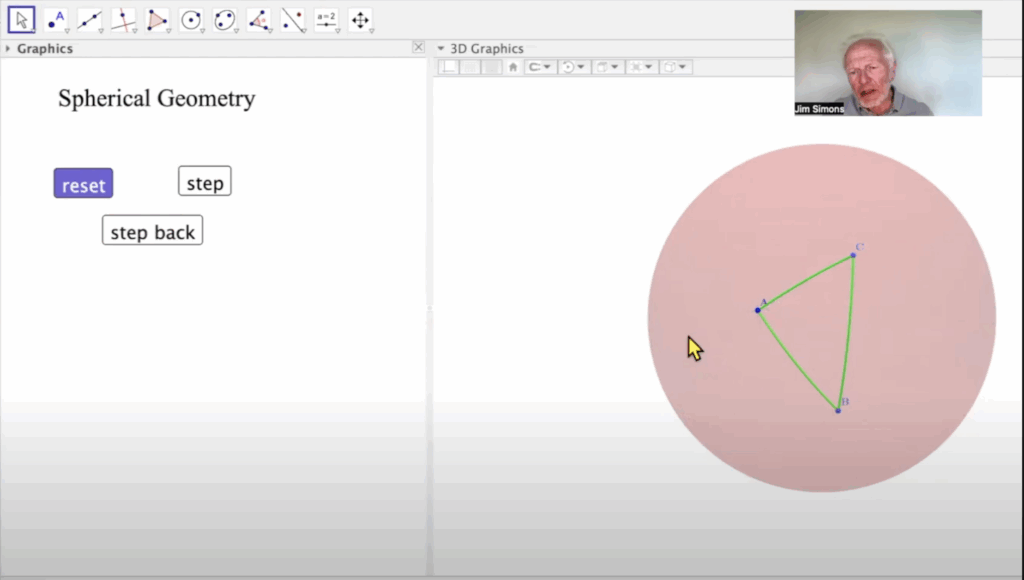\(-e^{i\pi}\) to Watch: Jim Simons
The Aperiodical 2025-06-02
In this series of posts, we’ll be featuring mathematical video and streaming channels from all over the internet, by speaking to the creators of the channel and asking them about what they do.
We spoke to retired mathematician and A-level maths tutor Jim Simons (not that Jim Simons) about his YouTube channel, in which he covers A-level maths topics.

Channel title: Jim Simons Link: youtube.com/channel/UCnYszOhEIIdIMYyNx2yjwfg Topics covered: Mathematics, mainly about A level Average video length: 20 minutes Recommended videos: Three pretty geometric theorems, proved by complex numbers; The Binomial Theorem with a Real Exponent; How We Used Log Tables
What is your channel about, and when/why did it start?
It is about mathematics, mainly around A level. It started in the pandemic when the Mathematical Association’s annual conference was cancelled, and I had to decide what to do with the talk I had prepared. As every teacher knows, there is no better way to really understand something than to try to teach it, and I’ve thought much more deeply about the A level material now than I ever did when I was being taught it, and I want to share some of that insight.
Who are you? Tell us about yourself.
In 2009, I retired from a career in the civil service as a professional mathematician, and took up tutoring, mainly at A level. I have always loved mathematics, and I quickly discovered that I love teaching it too. I joined the Mathematical Association, and have been an active member, writing for its journals, serving on its Teaching Committee, and going to its conference to share my ideas, and to listen to other maths teachers.
Who is the intended audience for the channel?
As with my very first video, I mostly imagine myself as talking to an audience of maths teachers who teach A level Maths and Further Maths, or similar levels around the world. So this is not a mass market channel, but of course anyone else interested in that sort of mathematics might enjoy it.
What is a typical video like?
I talk over powerpoint and also use geogebra, because I love moving diagrams. I usually try to produce rigorous proofs of the results I discuss. My videos are mostly about 20 minutes long, and it looks as though I do about 5 a year.

Why should people watch your videos?
I love hearing other maths teachers talk about their approach to the subject matter, and so I hope they might enjoy mine. I often feature enrichment ideas, or approaches that I think are novel, or sometimes just my favourite proofs of standard results. I often go a bit beyond A level in a way that I hope will be interesting and stimulating. I have become very interested in the history of mathematics, so I often include some history, which I think enriches and humanises the subject.
What are some highlights of the channel so far?
Three pretty geometric theorems, proved by complex numbers: This is my most popular video – the results are just so beautiful. Useful ideas for a Further Maths classroom! The history of the results is interesting too. The Binomial Theorem with a Real Exponent: The result is usually proved using Maclaurin’s theorem, but that’s not taught in English schools until later, which means that it isn’t really proved at all. So I have worked up a proof that doesn’t use calculus at all! This is an approach to proving the result that I have never seen elsewhere, and to judge by the comments, neither have a lot of people. It is quite advanced mathematics, so probably not really for use in the classroom, but I hope rewarding. How We Used Log Tables: When I was at school, we carried around a book of tables, as today’s kids carry a calculator, and indeed as most of their teachers did. I think teachers often talk about tables when they teach logs, but don’t necessarily have first hand experience of using them in earnest. So I made a video showing how they worked. I tackle some old O level questions that required the use of tables.
What exciting plans do you have for the future?
I am too old for long-term plans! But I am currently working on a video concerning a pretty little result about Pythagorean triangles. When I raised it at the recent joint mathematical associations conference, nobody knew it, so I decided to make the video. It is not especially deep, but gives me the opportunity to talk about and prove Heron’s formula for the area of a triangle, and Euclid’s formula for generating Pythagorean triples, both of which I love.